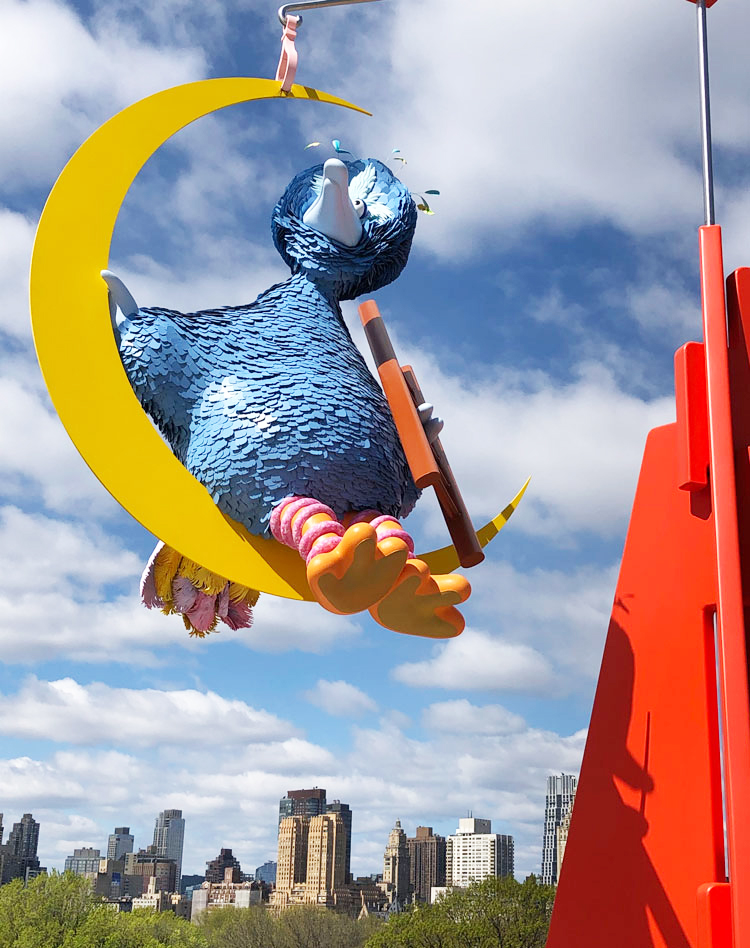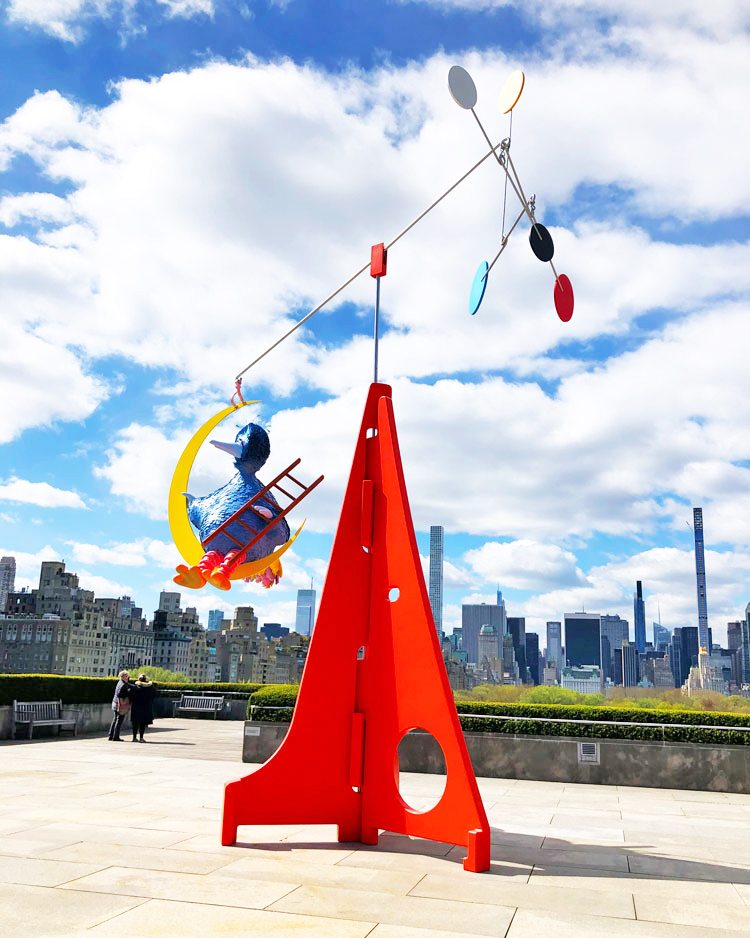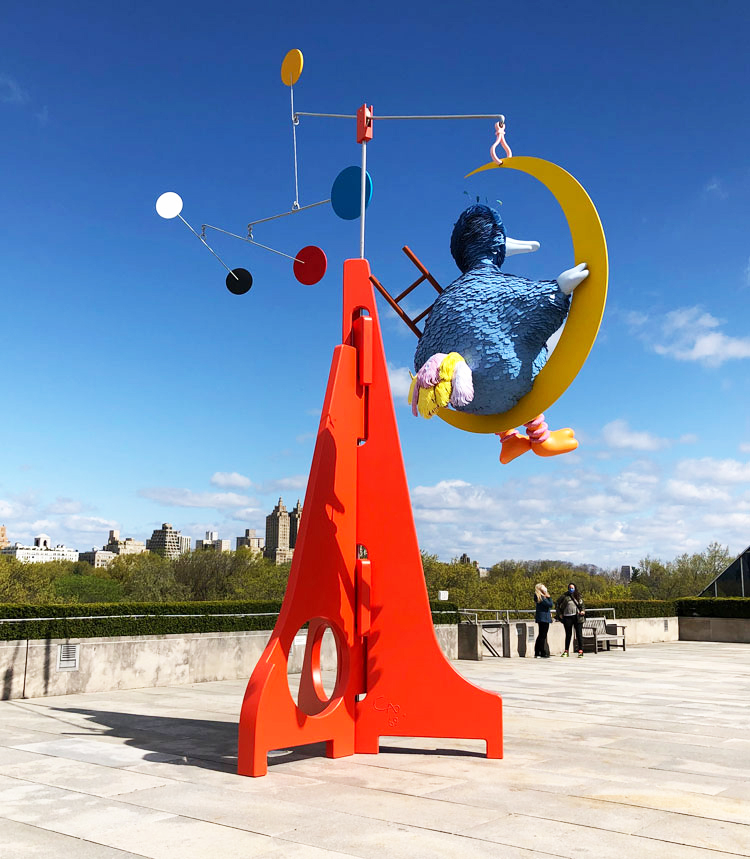
Iris and B Gerald Cantor Roof Garden, Metropolitan Museum of Art
16 April – 31 October 2021
by LILLY WEI
It’s a bird, a big bird, which the countless millions across the planet who have grown up with Sesame Street, the five-decade long children’s television programme will joyfully, proprietarily recognise as Big Bird. Here, however, their beloved friend has blue plumage instead of bright yellow, approximating the colour of the character’s South American cousin, Garibaldo, which Alex Da Corte (b1980, Camden, New Jersey) first saw on Sesame Street as a child in Venezuela. It might also remind us of the 1985 film Follow that Bird, in which our fine feathered friend was kidnapped by crooked, comically inept (and literal-minded) circus owners who painted him blue as a disguise and to coordinate with the song they force him to sing, I’m So Blue. (I say “him”, but how does Big Bird identify these days: he/him; they/them; it?) Da Corte, who also often disguises himself as other characters in his videos and other works, has long been fixated on Jim Henson and his Muppets, so making the amiable Big Bird the quixotic hero of his new installation, As Long as the Sun Lasts, seems almost predestined.

Alex Da Corte: As Long as the Sun Lasts, installation view, Iris and B Gerald Cantor Roof Garden, Metropolitan Museum of Art, 2021. Photo: Lilly Wei.
For this most recent edition of the Metropolitan Museum of Art’s popular outdoor installation series on the Cantor Roof Garden, Big Bird is perched gallantly, if somewhat precariously, within the curve of a yellow crescent moon (like the boy in the DreamWorks logo, who casts his fishing rod into space), scanning the changing horizon. He also looks a little lonely, minus his Muppet cohorts, no doubt feeling like many of us this past year minus ours. Da Corte gives Big Bird a short ladder to hold, as if it were a shield or an attribute, an implement that is no longer technically innovative but is nonetheless tried and true, weighted with historic and metaphoric associations. And because it is a two-way conveyance, it conveys an ambiguity of purpose – is this ladder for ascent or descent? Ad astra per aspera? Or a dive back to terra firma? Big Bird might be astutely hedging his bets.

Alex Da Corte: As Long as the Sun Lasts, installation view, Iris and B Gerald Cantor Roof Garden, Metropolitan Museum of Art, 2021. Photo: Lilly Wei.
Held aloft by a purposively DIY version of an Alexander Calder mobile/stabile combo, one with a base that suggests a sort of launchpad or plastic preschool gym of the kind from which many a tot (and perhaps future astronaut) has fearlessly self-launched. The flight pattern is restricted, pre-determined by the rods that balance Big Bird on his sliver of moon against five metal discs, four twirling beneath an upright yolky circle. They suggest planets orbiting the sun, all interconnected, all activated by random air currents, going around and around. Big Bird may not know exactly where he is going but, nonetheless, forges ahead doggedly, so to speak, even if that trajectory is in circles, spurred onwards by a commendable curiosity married to an equally commendable apprehension.

Alex Da Corte: As Long as the Sun Lasts, installation view, Iris and B Gerald Cantor Roof Garden, Metropolitan Museum of Art, 2021. Photo: Lilly Wei.
Made of stainless steel, aluminium and fibreglass, the installation is boldly coloured in Calderesque primaries that are slightly skewed – one disc more robin’s-egg blue and the base more maraschino cherry than a classic de Stijl blue or red, say, another instance of Da Corte making the familiar less so. The ensemble stands 26 feet (eight metres) high and this Big Bird seems to be roughly the same size as the original at just over 8 foot). But this avian is no softie, its feathers made from 7,000 laser-cut aluminium plaques (calculated by Sesame Street’s arithmomania-stricken Count?) to withstand outdoor exigencies. On its base is inscribed Da Corte’s version of Calder’s signature and the number 69. It refers to the year that Henson’s Muppets first appeared on Sesame Street, Apollo 11 landed on the moon, and what promised at the time to be a “giant leap” forward for “mankind,” as imagined by modernist idealists. This free-ranging, unpredictable, at times risky mashup of cultural icons, brand name logos, art history, history and more acts like imaginative detonations, firing up all sorts of little perceptual, critical fires.
The rather foreboding title, from an Italo Calvino short story about intergalactic travellers who roam the universe in search of a new planetary home, gives precedence to the sun, not the moon. After all, the fate of our corner of the cosmic neighbourhood depends entirely on the duration of the former. Da Corte deftly attaches Calvino’s quirky, often metaphysical musings on life and the space/time continuum as well as shelf loads of other science fiction and fabulist narratives to his installation’s themes, evoking the environmental, the existential, the eschatological, the playful, the tender and the woeful.
As Long as the Sun Lasts should draw crowds, enticed by Big Bird, to be sure, but also by an eagerness to be out and about once again, to see art in person, surrounded by the spectacular view of a greening Central Park framed by the crenellated Manhattan skyline. As New York and the world rebounds from more than a year of despair and uncertainty, we might all share the glee of a child whom I watched skip about the terrace, so happy to be outside under a blue sky, so happy to see his Sesame Street pal. And while we’re at it, we might remember a more familiar title: The Sun Also Rises – at least for now.
Jenny Saville: The Anatomy of Painting
Jenny Saville: This astounding show brings together the very best of an incomparable artist: absorbi...
From a mother bathing her children to cleaners working at the gallery, Margaret Salmon gives voice t...
Slavs and Tatars: The Contest of the Fruits
Rapping fruit, legendary birds and nail art feature in the UK debut of the Berlin-based collective S...
Liverpool Biennial 2025: Bedrock
From Sheila Hicks’s gemstone-like sculptures to Elizabeth Price’s video essay on modernist Catho...
Mikhail Karikis – interview: ‘What is the soundscape of the forthcomin...
Mikhail Karikis explains the ideas behind his new sound and video installation calling for action ag...
Art & the Book* and Spineless Wonders: The Power of Print Unbound**
Two concurrent exhibitions bring special collections into broader spaces of circulation, highlightin...
Focusing on the skills of wallpaper design and embroidery, this exhibition tells the story of the ...
Daphne Wright: Deep-Rooted Things
This show is a celebration of the domestic, and the poignant sculpture of Wright’s two sons, now o...
Anna Boghiguian: The Sunken Boat: A Glimpse into Past Histories
The venerable Egyptian Canadian installation artist Anna Boghiguian brings shipwrecks, shells and th...
Abstract Erotic: Louise Bourgeois, Eva Hesse, Alice Adams
A groundbreaking New York show from 1966 is brought back to life with the work of three women whose ...
Jeremy Deller – interview: ‘I’m not looking for the next thing. I...
How did he go from asking a brass band to play acid house to filming former miners re-enacting a sem...
Encounters: Giacometti x Huma Bhabha
The first of three exhibitions to position historic sculptures by Alberto Giacometti with new works ...
The Parisian scenes that Edward Burra is known for are joyful and sardonic, but his work depicting t...
The 36th Ljubljana Biennale of Graphic Arts: The Oracle
Surprising, thrilling, enchanting – under the artistic direction of Chus Martínez, the works in t...
It’s Terrible the Things I Have to Do to Be Me: On Femininity and Fame ...
In a series of essays about pairs of famous women, the cultural critic Philippa Snow explores the co...
Paul Thek: Seized by Joy. Paintings 1965-1988
A rare London show of elusive queer pioneer Paul Thek captures a quieter side of his unpredictable p...
This elegantly composed exhibition celebrates 25 years’ of awards to female artists by Anonymous W...
The first of its kind, this vast show is a stunning tour of the realism movement of the 1920s and 30...
Maggi Hambling: ‘The sea is sort of inside me now … [and] it’s as if...
Maggi Hambling’s new and highly personal installation, Time, in memory of her longtime partner, To...
Caspar Heinemann takes us on a deep, dark emotional dive with his nihilistic installation that refer...
Complex, multilayered paintings and sculptures reek of the dark histories of slavery and colonialism...
Shown in the context of the historic paintings of Dulwich Picture Gallery, Rachel Jones’s new pain...
William Mackrell – interview: ‘I have an interest in dissecting the my...
William Mackrell's work has included lighting 1,000 candles and getting two horses to pull a car. No...
Marina Tabassum – interview: ‘Architecture is my life and my lifestyle...
The award-winning Bangladeshi architect behind this year’s Serpentine Pavilion on why she has shun...
A cabinet of curiosities – inside the new V&A East Storehouse
Diller Scofidio + Renfro has turned the 2012 Olympics broadcasting centre into a sparkling repositor...
Plásmata 3: We’ve met before, haven’t we?
This nocturnal exhibition organised by the Onassis Foundation’s cultural platform transforms a pub...
Ruth Asawa: Retrospective / Wayne Thiebaud: Art Comes from Art / Walt Disn...
Three well-attended museum exhibitions in San Francisco flag a subtle shift from the current drumbea...
This dazzling exhibition on the centenary of John Singer Sargent’s death celebrates his versatile ...
Through film, sound and dance, Emma Critchley’s continuing investigative project takes audiences o...
Rijksakademie Open Studios: Nora Aurrekoetxea, AYO and Eniwaye Oluwaseyi
At the Rijksakademie’s annual Open Studios event during Amsterdam Art Week, we spoke to three arti...